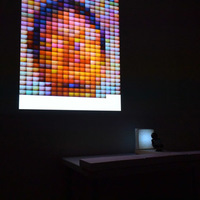Byeongwon Ha
University of South Carolina, Media Arts, Faculty Member
Nam June Paik is recognized for being known as the father of video art. However, some recent research about Paik focuses on his early interactive art. Since Exposition of Music – Electronic Television Revisited in 2009 represented his... more
Nam June Paik is recognized for being known as the father of video art. However, some recent research about Paik focuses
on his early interactive art. Since Exposition of Music – Electronic Television Revisited in 2009 represented his first solo show in Wuppertal in 1963, the study of his early interactive art has gained momentum. Nevertheless, regarding Paik a pioneer of interactive art is still a minor opinion in art history. This paper explores Paik’s rich background about his early interactive pieces. When he studied musicology and composition in Germany, he wrote several articles about new music for Korean readers from 1958 to 1959. These still remain unexplored materials for both Korean and Western scholars. Among them, “Chance Music” was written right after meeting John Cage. It reveals significant clues to articulate his fundamental concept about interactive art. Based on the music
background, Paik found how to appropriate musical instruments to make interactive art in his own way.
on his early interactive art. Since Exposition of Music – Electronic Television Revisited in 2009 represented his first solo show in Wuppertal in 1963, the study of his early interactive art has gained momentum. Nevertheless, regarding Paik a pioneer of interactive art is still a minor opinion in art history. This paper explores Paik’s rich background about his early interactive pieces. When he studied musicology and composition in Germany, he wrote several articles about new music for Korean readers from 1958 to 1959. These still remain unexplored materials for both Korean and Western scholars. Among them, “Chance Music” was written right after meeting John Cage. It reveals significant clues to articulate his fundamental concept about interactive art. Based on the music
background, Paik found how to appropriate musical instruments to make interactive art in his own way.
Research Interests:
Nam June Paik is mostly known as the father of video art. At the same time, he can also be regarded as a creative pioneer of interactive art. Unfortunately, most scholars and art historians still neglect Paik's remarkable achievement in... more
Nam June Paik is mostly known as the father of video art. At the same time, he can also be regarded as a creative pioneer of interactive art. Unfortunately, most scholars and art historians still neglect Paik's remarkable achievement in interactive art with his musical background. Especially, Paik's experience with Musique Concrète was a core springboard to develop his interactive pieces. However, among Paik's artistic backgrounds Musique Concrète is hidden by well-known influences from John Cage, Karlheinz Stockhausen and Fluxus. Based on Musique Concrète, Paik created basic elements of interactive art such as database, non-linearity and sensorial translation at Paik's first solo show, Exposition of Music – Electronic Television, in 1963. These are still considered fundamental properties to make interactive pieces. In this regard, Paik as an interactive artist can be a significant contribution to finding an origin of interactive art since art theorists have started to explore its genealogy.
